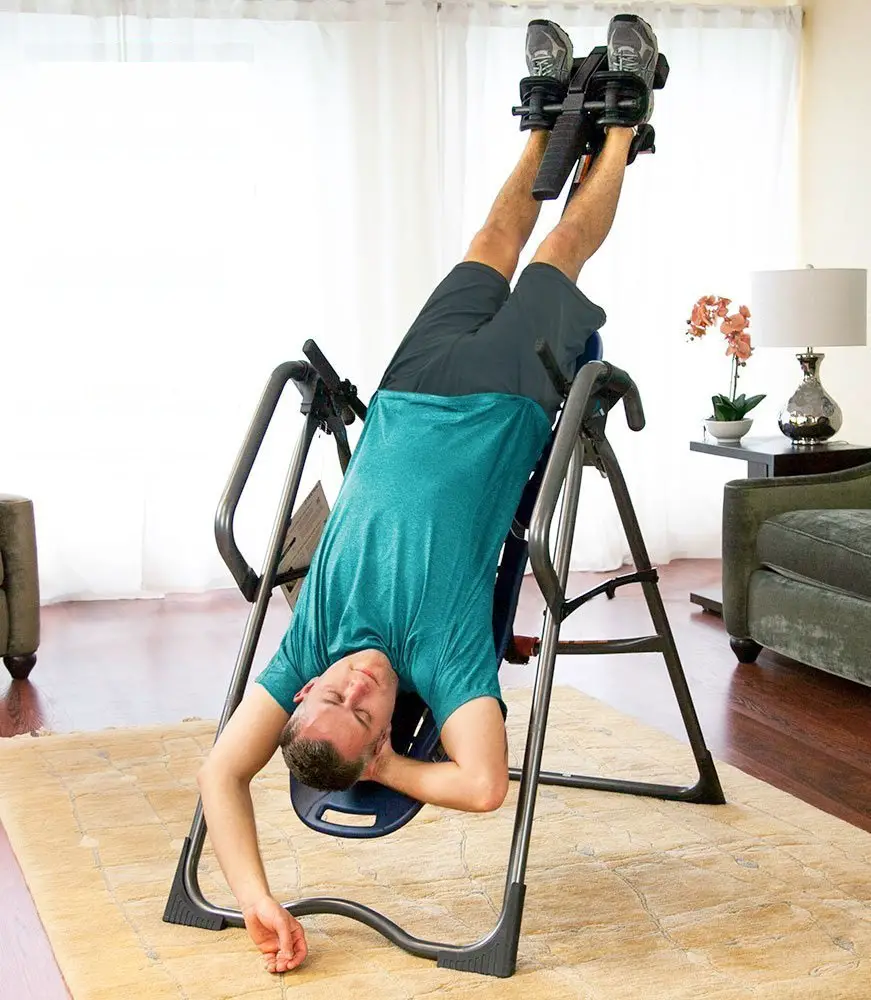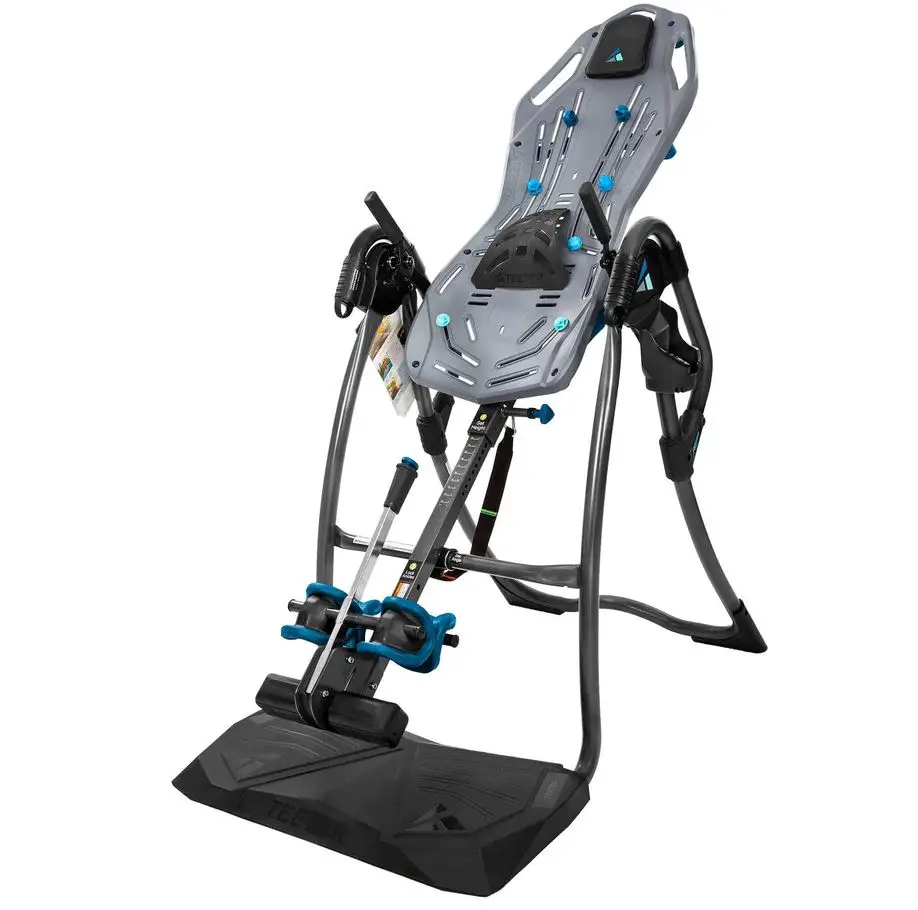If anyone you know has gotten rid of their back pain after inversion therapy, there is a high chance they will recommend the same to you. But there’s a reason why people need a degree to become a doctor, and this is it! As beneficial as inversion tables are for people with chronic back pains, sciatica, and scoliosis, they aren’t the safest – at least not for everyone!
There is much more to using inversion tables than suspending your feet in the air and tipping backwards on a table. Using the machine when you shouldn’t have can leave you with headaches, increased blood pressure and blurred vision. So, who should not use an inversion table? Read this post to find out!
What is An Inversion Table?
An inversion table is physical therapy equipment with a flat, cushioned table mounted on a fulcrum. You secure your feet to the table, lay flat against it, and flip yourself upside down by adjusting the levers.
How do Inversion Tables Work?
Inversion tables relieve the pressure of gravity on the nerve roots and spinal discs. This helps stretch your spine and extend the space between vertebrae. In a simpler, physics-free language, these recliner tables stretch the muscles and soft tissue surrounding them by applying a mild gravitational pull.
Who Should Use An Inversion Table?
Inversion tables are a godsend for people suffering from:
● Chronic back pain
● Kidney stones
● Muscle spasms
● Sciatica
● Scoliosis
● Compresses spinal discs
Inversion tables have proven to be an excellent short-term treatment for reducing back pain, improving spinal health, and increasing flexibility, ultimately reducing the need for surgery. According to a 2014 study, the zero-gravity concept implemented in inversion tables can lessen compression, delaying surgery.

Who Shouldn’t Use An Inversion Table?
After going through the many potential benefits of inversion tables, you must be wondering who shouldn’t use one and why. Although it has proven to be a piece of valuable physical therapy equipment, the inverted position isn’t the most accommodating. In short, people suffering from a medical condition that could worsen by increased blood pressure, intracranial pressure, or mechanical stress should not use an inversion table. Such medical conditions may include:
● Any physical or neurological illness that impairs strength, movement, consciousness, or cognitive function
● Cardiovascular conditions include:
○ heart disease
○ Stroke
○ high blood pressure
○ Hypertension
○ Use of anticoagulants (like a high dose of aspirin)
● Damage to the spine or bones and joint conditions like:
○ herniated discs
○ Fractures
○ Spinal curvature
○ Swollen joints
○ Osteoporosis
○ Dislocation
○ Implanted orthopaedic support
● Any neurological dysfunction, including:
○ a traumatic brain injury
○ history of intracranial bleeding
○ a risk of TIA or mini-stroke
○ acute migraines
● Any ailment affecting the eyes, ears, or nose, including:
○ cerebral sclerosis
○ Vertigo
○ Myopia
○ Glaucoma
○ ear infections
○ conjunctivitis (pink eye)
○ Chronic sinusitis
● Any physical or neurological disorder that causes:
○ weakness or neuropathy
○ Seizures
○ sleep disorders
○ Lightheadedness
○ Dizziness
○ exhaustion
● Any digestive or internal ailment, including:
○ gallbladder or renal problems
○ severe gastrointestinal problems
○ hiatal or other hernias
● Any medical condition for which a doctor has advised against, restricted, or prohibited exercise, like:
○ Pregnancy
○ Obesity
○ Hip/knee condition
○ A recent surgery
○ Use of blood clotting medications
Potential Risks of Inversion Tables
Telling someone they can’t do something is never enough to stop them from doing their way. So, it’s only fair that we explain the potential risks of using an inversion table when you shouldn’t:
1- Headaches
Headaches are the most common side effects people face after undergoing inversion table therapy sessions. Increased blood flow to the brain causes severe pressure on the nerves, explaining such after-effects. Even though these headaches are usually short-term, some people have reported recurrent migraines.
2- Surging Blood Pressure
Several studies associate inversion table therapy with patients’ rising blood pressure levels. According to some research, inversion therapy causes substantial rises in both systolic and diastolic blood pressure. In a 1986 experiment, 18 men reported that being upside down for 7 minutes raised their blood pressure. So, if you are suffering from hypertension, inversion table therapy might not be ideal for you.
3- Blurred Vision
You might experience blurred vision after inversion therapy sessions, especially if you wear contact lenses. Some people, usually those with optical conditions, even experience a rip or detachment in the retina of their eye.
Tips to Safely Use An Inversion Table
Even if you don’t have any of the above-mentioned medical conditions, you shouldn’t take the exercise easy. It is best to stay cautious when using an inversion table without expert supervision – better safe than sorry, you know! Here are some tips you can implement to have a safe inversion table therapy session:
● Safety First
The last thing you want is to slip out of the inversion table. You should use safety harnesses to strap your feet to the machine.
● Ask Someone to Stand Close By
Inverting on a table with your feet strapped and being unable to flip back is never a good idea. So, just in case, have someone to keep an eye on you.
● Keep the Duration of Your Sessions Short
Unless you want to end up with an excruciating migraine, adopt the “slow and steady” rule. You want to gradually make your body used to the increased blood flow to the head instead of bombarding it with every ounce of blood in your body without a heads up (get it – because your head will be down!). Start with 2 to 3 minutes a day and gradually add 5 minutes to subsequent therapy sessions.
● Monitor the Angle at Which You Lean
The effects of inversion table therapy start kicking in at around 20 to 30 degrees of incline. Even if you’re trying to be experimental, don’t recline at more than a 45-degree angle.
● Don’t Rush to Get Off the Machine
You’ve followed all the tips and gotten through your inversion table therapy session without pulling an unwanted muscle. But just when you thought you were done, you jerk up quickly – looks like you’ve invited a muscle spasm! But you can avoid it by showing patience in getting off the machine.
Conclusion
Inversion tables aren’t new technology; numerous physical therapists and chiropractors use this inversion therapy equipment to tend to various health issues. However, this is only a short-term measure, which can worsen the situation for people who should not use an inversion table.
So, we suggest you go through our list again and make sure whether you should use an inversion table before buying it, or better yet, give your medical history to a physician and hear what they have to say!





